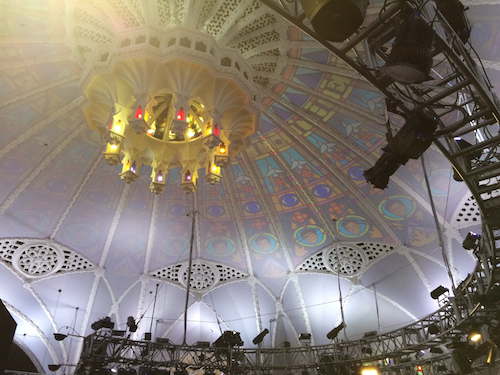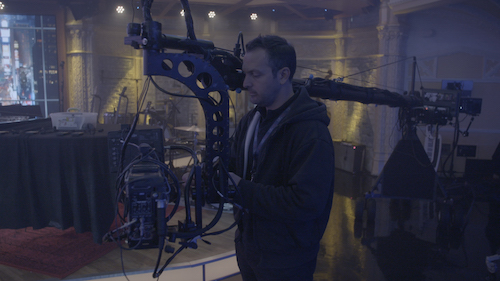“Right now it’s a pile of dust, but it’s going to be beautiful.”
That’s what Stephen Colbert told GQ last August about the renovation of The Ed Sullivan Theater, where he hosts “The Late Show with Stephen Colbert.” Thanks to the hard work of New York Local 1212, he was right.
“A tremendous amount of work was done and in a very short amount of time. I can’t tell you how proud I am of our guys,” said Local 1212 Business Manager Ralph Avigliano.
When the first “The Late Show with Stephen Colbert” aired on Sept. 8, viewers saw not just a new host but a new set complete with state-of-the-art technology. And it was all done in just over three months. And an IBEW Media Department crew was there to capture this video, posted today.
At its height, the renovation, which included removing the previous set vacated in May by David Letterman, employed close to 100 members, said CBS Vice President Richard Hart. About 30 members work on the show as in-house technicians.
The newest incarnation of “The Late Show” broadcasts from the same space as its predecessor in the historic Ed Sullivan Theater. But the look is entirely new and reveals much of the original architecture.
The 13-story historic landmark dates back to 1927 and was originally a Broadway theater. That near-90-year-old design was what Colbert wanted to uncover. So Local 1212, along with other trades, removed the post-Broadway layers, peeling off years of entertainment history.
While the architecture harkens back to days gone by, the sound system is entirely new, along with other modern technological advances. The cutting edge set includes an all-digital projection mapping system that plays in the newly uncovered dome, LED lights covering one-third of the set and new seats.
“When you see this dome, and the architecture of the old and the new technologies coming together to create this environment, you can see that it was an incredible undertaking,” Avigliano said. “And the expertise of the IBEW is exactly what was needed to make it happen.”
During the narrow timeframe between the final Letterman taping and Colbert’s debut, the crew had to essentially gut the old set and build a new one. They removed old sound baffling equipment and air ducts, and built and installed a new lighting grid, including a new wall monitor in the control room. They also designed and installed an elliptical lighting truss. And while all this was happening, they were also ripping up three office floors in need of audio-visual capability.
“There was a lot of dust,” said Tim Kennedy, technical manager for “The Late Show.” “But we got it done. Kudos to the working men and women who pulled it off.”
Renovating the Past, Projecting the Future
The renovation of a theater that once hosted acts from the Beatles to the Ringling Brothers circus led to interesting discoveries. Stained glass and “elephant columns” were discovered below the stage. The columns date to Sullivan’s insistence on a live elephant on stage, and the columns added necessary support.

|
| Among the new set features are a dome, from the original architecture, with digital projection mapping.
|
They also uncovered a dome complete with a chandelier, which itself was littered with old cigar stubs from its then-caretaker. Now this vaulted space is home to one of the most technologically innovative elements of the show. Made of plaster and steel with acoustic paneling strategically located throughout the space, the dome is approximately 5,600 square feet and measures approximately 80 feet in diameter.
Outfitted with LED lights, the dome is now home to projection mapping. Each night, as Local 1212 camera operators tape the show, they pan to the dome. Depending on the night, viewers will see anything from images of Colbert to spinning star constellations reminiscent of a show from New York’s Hayden Planetarium.
“It’s a blank canvass that allows us to show off a new technology alongside the grandeur of the theater. And it’s something that was hidden during the Letterman years,” Kennedy said.
The projection mapping is done in part through another new addition, an elliptical lighting truss comprised of six projectors. The shape was chosen to make sure the projectors could hit their targets without blocking views of the dome, including from Colbert’s desk.
“It’s a very unique design for TV and for here, and it works well,” Kennedy said.
A Collaborative Art Form
Local 1212 worked alongside CBS’s construction crew, design companies and other trades including IATSE and the Carpenters. Within their own ranks there was a collaboration on the production side as well since Colbert brought most of his staff from his previous show with him. Despite the small window of time and the extent of the renovation, everything was ready for the debut.
“It’s been a long ride and I’m really proud of what we pulled off,” Kennedy said.
Once the construction was done, the theater was handed over to Local 1212 to get the cameras wired, the LED walls installed with proper feeds and the servers loaded.
“It all gets done when you’ve got good people around you, supporting you,” Kennedy said. “I never really heard someone say ‘no.’ The requests would come in and the next day they were done.”
Local 1212 members take a great deal of pride in the day-to-day level of expertise. Harvey Goldberg has been responsible for the music mixing, both for the house band and feature bands, for about 20 years. Despite his long experience, he’s still grateful for what he gets to do, and of the people he gets to work with.

|
| A mix of New York Local 1212 members, some veterans of CBS and David Letterman and some from Colbert’s previous show like Wade Latz, pictured, now work together to produce the new Late Show.
|
“It’s a collaborative art form,” Goldberg said. “It’s a very privileged situation to be working on such a high profile project with someone as talented as Stephen, with such a talented crew of people. And in such a legendary theater.”
A Local 1212 member since 1959, John Michaeljohn has been a cameraman for over 50 years. “Here I am, still playing with the other kids in the sandbox,” he said.
Michaeljohn came from Colbert’s previous show, one of many that made the transition. For him, it was easy.
“It’s worked especially well,” he said. “Everyone’s like old shoes. It’s very comfortable.”
The renovation was done as a Code of Excellence project, but as Avigliano noted, in broadcasting the code is par for the course. “We assume we’re the best in the business and we live by that code, and you can see it in the results.”
Still, the grandeur of the space and the feats they achieved during the renovation, not to mention the daily excitement of working on such a high profile show, isn’t lost on anyone.
“Some of us are second and third-generation IBEW broadcasting, and with CBS. We’re just awed by it all,” Avigliano said. “I remember watching the first Letterman show. I worked in the videotape department then. Now as a business manager, it’s very exciting to see. It brought me back to the early days. I have a lot of pride in watching this history and where we are today.”
Jay Morgan, a monitor mixer, works backstage. “There is a feeling I still get every day, when the lights go out and I hear the roar of the crowd. That’s it. It’s on. You get that adrenaline rush, even back here in the dark, you still get it.”
Watch the IBEW-produced video of the renovation here.